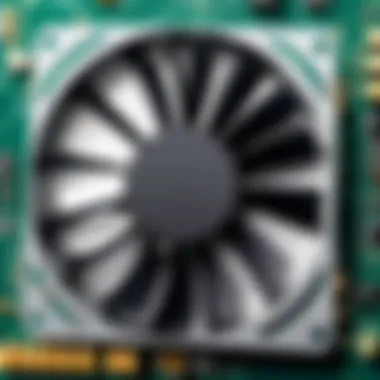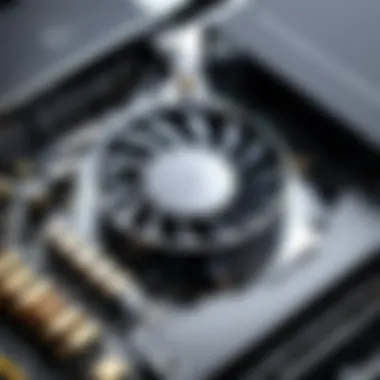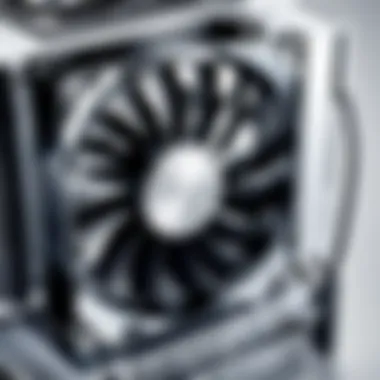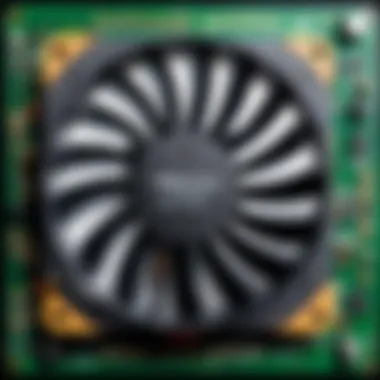Unleashing the Power of PWM Fans: A Deep Dive into Computer Hardware Cooling Systems


Product Overview
In the realm of computer hardware cooling systems, PWM fans stand out as essential components for regulating temperature and maintaining efficient performance. These fans utilize Pulse Width Modulation (PWM) technology to control fan speed accurately, ensuring optimal cooling without unnecessary noise or power consumption. Brands like Corsair, Noctua, and Cooler Master are well-known for their high-quality PWM fans, offering a range of specifications to cater to diverse system requirements. Key specifications to consider when selecting a PWM fan include fan size, RPM range, airflow capacity, and noise levels. Prices vary based on the brand and features, with some premium models offering advanced cooling solutions for enthusiasts seeking top-tier performance.
Performance Comparison
To gauge the effectiveness of PWM fans, benchmark tests play a crucial role in determining speed, efficiency, and overall performance. Comparing different PWM fans based on factors like airflow, static pressure, and noise levels helps users make informed decisions to optimize system cooling. By assessing speed and efficiency under various load conditions, users can identify the most suitable PWM fan for their specific hardware setup. Detailed comparisons of fan performance provide valuable insights into how these components contribute to enhancing overall system functionality and longevity.
Features and Technology
PWM fans come equipped with unique features and technological advancements that set them apart in the market. From customizable RGB lighting to anti-vibration pads, these fans offer versatility and functionality beyond basic cooling duties. Some models integrate smart technology for automatic fan speed adjustments, syncing with temperature sensors to maintain optimal performance. Compatibility with a wide range of devices, including CPU coolers, radiators, and case fans, ensures seamless integration into diverse system configurations. Users benefit from the innovative design elements and advanced technology that PWM fans bring to the table.
Pros and Cons
Assessing the strengths and weaknesses of PWM fans is essential for users looking to make informed purchasing decisions. The pros of PWM fans include efficient temperature regulation, reduced noise levels during operation, and customizable speed profiles for tailored cooling solutions. However, some areas for improvement may include price point for high-end models, potential compatibility issues with older motherboards, and the learning curve associated with optimizing fan control software. By weighing the pros and cons of PWM fans, users can determine whether these components align with their specific hardware requirements and performance expectations.
Value for Money
When evaluating the value proposition of PWM fans, considerations around cost-effectiveness, long-term benefits, and comparisons with similar products come into play. While premium PWM fans may come at a higher price point initially, their long-term benefits in terms of improved system stability and enhanced cooling efficiency can outweigh the initial investment. Comparing the features, performance, and pricing of PWM fans against alternative cooling solutions helps users understand the overall value they provide. By analyzing the cost-effectiveness and advantages offered by PWM fans, users can make informed choices that align with their budget and performance priorities.
Introduction
PWM fans play a crucial role in computer hardware cooling systems, offering a more efficient and precise method of regulating fan speed. Understanding the nuances of PWM technology is essential for optimizing fan performance and enhancing overall system efficiency. By delving into the intricacies of PWM fans, one can grasp their significance in maintaining stable operating temperatures and ensuring the longevity of hardware components. This article serves as a comprehensive guide to unleash the true power of PWM fans in computer hardware systems.
Defining PWM Fans
Understanding Pulse-Width Modulation Technology
Pulse-Width Modulation (PWM) technology involves altering the power signal sent to the fan motor, controlling its speed by modulating the width of the electrical pulses. This method provides a more precise and efficient way to adjust fan speeds compared to traditional methods. The key characteristic of PWM technology lies in its ability to regulate fan speed dynamically, responding to temperature changes effectively. This dynamic speed adjustment not only optimizes cooling but also conserves energy, making PWM fans a popular choice for enhancing system performance.
Function of PWM Fans in Computer Cooling
The function of PWM fans in computer cooling is to maintain optimal operating temperatures by adjusting fan speeds according to the heat generated by hardware components. This adaptive cooling mechanism ensures that the system remains within safe temperature limits, preventing thermal throttling and potential hardware damage. The unique feature of PWM fans lies in their ability to operate quietly at lower speeds and ramp up when necessary, balancing efficient cooling with minimal noise output. While the advantages of PWM fans include smoother operation and reduced noise levels, some may find their initial cost slightly higher compared to conventional fans.
Importance of Effective Cooling
Impact of Temperature on Hardware Performance


The impact of temperature on hardware performance cannot be understated, as overheating can significantly reduce the efficiency and lifespan of computer components. High temperatures can lead to decreased processing power, system instability, and even permanent damage to hardware. Maintaining optimal operating temperatures is crucial for ensuring consistent performance and longevity for your computer system. The significance of efficient cooling solutions, such as PWM fans, lies in their ability to regulate temperatures effectively, mitigating the risks associated with overheating.
Significance of Maintaining Optimal Operating Temperatures
The significance of maintaining optimal operating temperatures goes beyond just performance optimization; it is a critical factor in preserving the durability of hardware components. By ensuring that the system operates within the recommended temperature range, users can minimize the risk of premature hardware failure and performance degradation. PWM fans excel in this aspect by providing a reliable means of cooling that adapts to workload demands, maintaining a healthy thermal environment for all system components. The advantages of keeping temperatures in check far outweigh the potential drawbacks of inadequate cooling, making the investment in PWM technology a worthwhile endeavor.
PWM Fan Mechanics
Within the realm of computer hardware, understanding the intricacies of PWM fan mechanics is paramount for optimizing cooling systems. The internal structure and controller circuitry play pivotal roles in ensuring efficient temperature regulation within the system. Delving into the internal components reveals the sophistication involved in enhancing fan performance.
Internal Structure of PWM Fans
Blades and Housing Design
The blades and housing design of PWM fans are meticulously crafted to maximize airflow while minimizing noise levels. The aerodynamic shape of the blades allows for efficient air circulation, ensuring that components receive adequate cooling. The housing design complements this by providing a secure enclosure for the blades, reducing vibrations and enhancing overall stability. This design choice is popular among tech enthusiasts and gamers for its ability to maintain optimal operating temperatures without producing excessive noise.
Motor and Bearing Systems
The motor and bearing systems of PWM fans are engineered to provide smooth and reliable operation. The key characteristic of these systems is their ability to sustain continuous fan speeds without compromising performance. The motors are designed to deliver precise rotations, contributing to the consistent airflow essential for cooling hardware components effectively. Additionally, the bearing systems reduce friction, prolonging the lifespan of the fan. While these components enhance fan efficiency, potential drawbacks may include increased energy consumption due to the continuous operation of the motor.
PWM Controller Circuitry
The PWM controller circuitry is fundamental in regulating fan speed and optimizing performance. By adjusting the voltage supplied to the fan motor, this circuitry allows for precise control over fan speeds, enabling users to tailor airflow according to system requirements. The ability to regulate voltage for fan speed control is a beneficial feature, particularly in maintaining stable temperatures during intense computing tasks. However, while this system provides excellent control, it may lead to increased energy consumption when running fans at higher speeds.
Regulating Voltage for Fan Speed Control
Regulating voltage for fan speed control allows users to fine-tune cooling performance based on workload demands. This feature ensures that hardware components receive adequate airflow to prevent overheating, ultimately optimizing system efficiency. The unique aspect of this functionality lies in its responsiveness to fluctuating temperature levels, adapting fan speeds accordingly. While advantageous in maintaining hardware integrity, it is essential to consider the energy implications of running fans at varying speeds.
Achieving Variable Speeds
Achieving variable speeds through PWM technology offers users the flexibility to customize cooling solutions based on specific requirements. The key characteristic of this feature is its ability to dynamically adjust fan speeds based on real-time feedback, ensuring consistent airflow levels. This adaptability is crucial for intensive computing tasks that demand varying cooling levels. However, a potential disadvantage of this system may be the generation of additional noise at higher fan speeds, necessitating a balance between performance and acoustics for an optimal user experience.
Advantages of PWM Technology
PWM (Pulse-Width Modulation) technology offers significant advantages in enhancing the performance and efficiency of computer hardware cooling systems. One of the key benefits of PWM technology is its capability for dynamic speed adjustment. This feature allows the fan to adapt its speed according to the temperature requirements of the system, leading to optimized cooling and energy efficiency. By modulating the width of the pulses, PWM fans can precisely control the fan speed, resulting in more effective cooling without unnecessary power consumption.
Moreover, PWM technology contributes to energy savings by operating the fan at varying speeds based on real-time thermal conditions. This adaptive speed mechanism ensures that the fan runs at higher speeds only when necessary, reducing energy consumption during idle or low-temperature periods. The ability of PWM fans to adjust their speed according to the cooling demands of the system not only enhances performance but also minimizes power wastage, making them a preferred choice for efficient cooling solutions in computer hardware.
Enhanced Efficiency


Dynamic Speed Adjustment
Dynamic speed adjustment is a core feature of PWM technology that allows the fan to change its rotational speed in response to temperature changes. This adjustment is vital in maintaining optimal operating temperatures within computer systems. By automatically scaling the fan speed based on the heat generated by hardware components, dynamic speed adjustment ensures that cooling performance remains efficient at all times. This flexibility prevents overheating issues and helps prolong the lifespan of computer hardware by providing customized cooling solutions as needed.
Energy Savings
The energy-saving aspect of PWM technology stems from its ability to regulate fan speed according to thermal requirements. Unlike traditional fans that operate at a constant speed, PWM fans adjust their speed dynamically, consuming less power when cooling demands are lower. This adaptive behavior not only reduces energy wastage but also contributes to lower electricity bills over time. By optimizing energy usage without compromising cooling efficiency, PWM technology stands out as a cost-effective solution for maintaining hardware performance while minimizing environmental impact.
Noise Reduction
Smooth Operation
Smooth operation is a key attribute of PWM fans that enhances overall user experience. The technology behind PWM fans ensures that speed transitions are seamless and produce minimal vibrations, resulting in quieter operation. This smooth performance not only reduces noise levels but also enhances the comfort and tranquility of the computing environment. Users can enjoy a peaceful workspace without being disturbed by disruptive fan sounds, thanks to the refined operation of PWM fans.
Minimizing Fan Noise
Minimizing fan noise is a critical advantage of PWM technology that caters to individuals seeking a quieter computing environment. PWM fans excel in reducing noise pollution by controlling fan speed effectively. By adjusting the RPM (Revolutions Per Minute) based on temperature fluctuations, PWM fans can operate at quieter levels when cooling demands are low. This noise-reduction feature enhances user concentration, prevents distractions, and promotes a conducive working or gaming atmosphere. Choosing PWM fans for noise-sensitive environments ensures a harmonious blend of efficient cooling and peaceful operation.
Application of PWM Fans
When delving into the intricate realm of PWM fans in computer hardware, understanding their application becomes paramount. The utilization of PWM fans plays a crucial role in maintaining optimal operating temperatures, thus directly impacting hardware performance. By optimizing cooling systems with PWM technology, users can ensure efficient and stable operation of their computer components, ultimately enhancing overall system efficiency.
Gaming Rigs
Optimizing Cooling for High-Performance Gaming
Implementing high-quality PWM fans is essential for optimizing cooling in high-performance gaming rigs. The specific aspect of enhancing cooling efficiency not only aids in preventing overheating during intensive gaming sessions but also contributes to the longevity and sustained performance of hardware components. The key characteristic of this optimization is its ability to regulate fan speeds effectively, ensuring that the system operates within safe temperature limits at all times. This feature is highly beneficial for gamers looking to push their hardware to the limits without compromising on stability. The unique advantage of optimizing cooling for high-performance gaming through PWM fans lies in the precision control and dynamic adjustment of fan speeds, providing adequate cooling exactly where and when it is needed most.
Maintaining Component Longevity
Another vital aspect facilitated by PWM technology in gaming rigs is the maintenance of component longevity. By efficiently cooling critical hardware components such as the CPU and GPU, PWM fans play a significant role in prolonging the lifespan of these components. The standout characteristic here is the ability of PWM fans to operate at varying speeds based on real-time temperature fluctuations, ensuring that components are consistently kept cool under varying workloads. This functionality is a popular choice for gamers as it not only protects their investment in high-end hardware but also contributes to sustainable and reliable performance over time. The unique advantage of maintaining component longevity through PWM fans is the balance it strikes between optimal cooling and reduced wear and tear on hardware, ultimately enhancing the overall durability of the system.
Selecting the Right PWM Fan
When diving into the world of PWM fans, selecting the right one becomes crucial for optimal computer hardware cooling. Choosing the appropriate PWM fan involves considering various aspects that directly impact performance and efficiency. The compatibility with motherboard headers and the optimal fan size are key elements to focus on.
Considerations for Purchase


Compatibility with Motherboard Headers
The compatibility with motherboard headers plays a crucial role in ensuring seamless integration of the PWM fan with the computer system. It determines the ease of connection and control, making it a vital consideration for efficient cooling. As a popular choice for this article, compatibility with motherboard headers allows for direct and precise control over fan speed and settings. This feature streamlines the setup process and enhances overall system management. However, the downside might be limited options for customization but is outweighed by the hassle-free installation and operation that this compatibility provides.
Optimal Fan Size
Optimal fan size is another critical factor to deliberate when selecting a PWM fan. The size of the fan directly affects the airflow and cooling capacity, influencing the system's overall temperature management. Optimal fan size ensures efficient heat dissipation and airflow within the system, contributing to enhanced performance and longevity of hardware components. For this article, optimal fan size guarantees effective cooling without compromising space or noise levels. It offers a balance between cooling power and system compatibility, providing an ideal cooling solution for various computer setups.
Top PWM Fan Brands
When exploring PWM fan options, delving into top brands can provide valuable insights into performance and reliability.
Performance Reviews
Performance reviews offer detailed assessments of how PWM fans from different brands fare under various conditions. Understanding these reviews is essential for making an informed decision when selecting a PWM fan. For this article, focusing on performance reviews sheds light on the capabilities and limitations of each fan brand. It helps users gauge the efficiency and effectiveness of PWM fans in maintaining optimal operating temperatures, ensuring stable performance during demanding tasks.
Reliability Ratings
Reliability ratings serve as a benchmark for evaluating the trustworthiness of PWM fan brands in the market. These ratings encompass factors like durability, build quality, and product lifespan, offering users insights into the longevity and performance consistency of PWM fans. In the context of this article, emphasizing reliability ratings enables users to prioritize durability and product quality while selecting a PWM fan. It empowers users to make informed choices based on the long-term reliability and performance of the fan brands.
Installation and Maintenance
In the world of computer hardware, the installation and maintenance of PWM fans play a critical role in ensuring optimal system performance and longevity. Proper installation and regular maintenance of these fans can significantly impact the cooling efficiency of the entire system. When it comes to installation, users must pay close attention to details such as mounting, wiring, and connection to the motherboard headers. This ensures that the fan operates smoothly and effectively, contributing to overall system stability and performance. Additionally, regular maintenance is essential to prevent dust build-up, which can hamper airflow and cooling capabilities over time.
Proper Mounting
Positioning for Airflow Efficiency:
Positioning the PWM fan for optimal airflow efficiency is crucial to maximize cooling effectiveness. By placing the fan in a strategic location within the chassis, users can ensure that hot air is efficiently expelled, and cool air is drawn in. This process helps in maintaining lower operating temperatures for key components, thereby enhancing system performance and reliability. The key characteristic of positioning for airflow efficiency lies in creating a balanced airflow path throughout the system, promoting efficient heat dissipation and reducing the risk of overheating.
Securing the Fan in Place:
Securing the PWM fan securely in place is vital to prevent any operational issues or damage. Properly securing the fan ensures that it remains stable during operation, reducing noise from vibrations and enhancing overall system safety. This feature is popular among users as it not only enhances the longevity of the fan but also minimizes any potential risks associated with loose components. One unique advantage of securing the fan in place is that it maintains consistent airflow direction, promoting efficient cooling and system performance.
Cleaning and Lubrication
Proper cleaning and lubrication of PWM fans are essential maintenance tasks that can prolong the lifespan of the fan and ensure smooth operation over time. By preventing dust build-up on the fan blades and motor, users can maintain optimal airflow efficiency and cooling performance. Regular cleaning intervals help in preserving the fan's balance and minimizing potential noise issues due to dust accumulation.
Preventing Dust Build-Up:
Preventing dust build-up is crucial in maximizing the airflow efficiency of PWM fans. Dust accumulation on the blades and housing can obstruct airflow, leading to decreased cooling performance and potential overheating of system components. By keeping the fan clean and free from dust, users can preserve the fan's effectiveness and maintain consistent cooling capabilities. This practice is highly beneficial for improving system reliability and longevity.
Ensuring Smooth Operation:
Ensuring smooth operation involves proper lubrication of the fan's motor and bearings. This maintenance step reduces friction within the fan assembly, promoting quiet and efficient performance. By lubricating the moving parts regularly, users can prevent wear and tear, prolonging the fan's lifespan and optimizing its operational efficiency. One key advantage of ensuring smooth operation is the minimization of noise levels, creating a more comfortable environment for users while enhancing overall system functionality.







